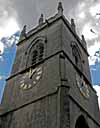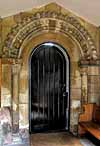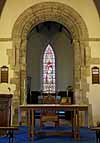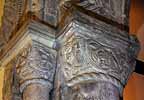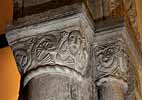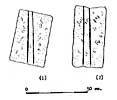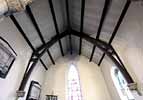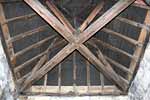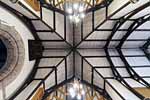For this church:    |
Rossington St MichaelArchaeology
The church comprises an aisleless nave with south porch, north and south transepts, chancel with vestry to north, and west tower. The whole of the nave, south porch, transepts, and chancel, with the exceptions of the south doorway and the chancel arch, date from a rebuilding of 1840-4. The vestry on the north side of the chancel originally also dated to this phase of rebuilding but was modified and enlarged in 1897. The windows throughout nave and transepts are plain lancet form, neo-Early English. The chancel has a neo-Norman doorway and window on the south elevation and the east window is again a lancet in Early English style.
The west tower represents the only substantial section of the building to remain from the medieval church. It dates from the mid to late 14th century and is constructed entirely from Magnesian limestone in contrast to the Victorian rebuilding of the body. It is of four stages with string courses defining each stage; construction is uniformly of ashlar. The west doorway has a hoodmould and appears 14th century; the west window above has plain Perpendicular tracery and is of three lights. The belfry openings on all four elevations are of pointed, two-light form with panel tracery and hoodmoulds, having human face label stops. There is an embattled parapet with eight crocketed pinnacles. The tower contains two internal chambers, the lower housing the clock and the upper the bells. Each is accessed via a newel stair at the south-west angle, which also affords access to the roof. There are various graffiti on the stair walls, one particularly fine example in cursive script records the name Geo. Lister Bentley and the date 1809. The oak bellframe is an important example of a Pickford Group 5.O variant. The main roof is pitched, with tile covering, and is probably 19th century.
The interior of the body contains a Norman font and a 15th century pulpit. The south doorway, although partially restored, is basically of the 12th century. The inner order is plain and uncarved and probably represented a re-cutting or 19th century replacement. The outer arch has an order of beakheads, the profile being unusual: in the soffit it is plain and chamfered; on the face, at the angle, there is a roll; a plain element, a wide hollow, and a plain element again meet the label. The beakheads are placed between the roll and the label; their beaks appear to dig into the roll moulding, but this may be the effect of foreshortening and the tips being hidden by the roll. The heads of the most decayed examples are wide, with several rows of feathers across the forehead.
The chancel arch is 12th century, round-headed, and features two orders and a label, it does not appear to have undergone any restoration. The arch has re-entrant jambs with short shafts and half-round responds starting unusually high up above the floor level. The high positioning of the decorative portion of the arch implies the possible existence of a former screen; a similar example is found at nearby Frickley, West Yorkshire: http://www.crsbi.ac.uk/site/3391/. The capitals are superbly decorated with foliate ornament and human faces. The inner order has zig-zag moulding on the west side and a pelleted outer order below a billeted hood. There is a label above the arch comprising foliate ornament, the detail differing with almost every stone. A detailed description of the chancel arch may be found at: http://www.crsbi.ac.uk/site/5641/ Medieval Cross Slabs
There are the fragmentary remains of two plain sections of cross shaft in the north interior wall of the tower at ground floor level. These are now obscured by furniture. Description and drawings of the cross slab fragments courtesy of Peter Ryder. Technical SummaryTimbers and roofsBellframeHigh-sided oak frame, Pickford Group 5.O but with a king post instead of queen posts. The side braces are widely splayed and have no jack braces. One post has carved detail including a roll moulding and may be reused. The frame is stylistically pre-C19th. Walls
Excavations and potential for survival of below-ground archaeologyNo known archaeological excavations have been undertaken. The fabric dates principally from the C12th to the C19th. There was a major restoration in 1840-4 when the body of the church, with the exception of the chancel arch and south doorway, were rebuilt entirely. The tower is of the C14-15th with some C19th restoration (roof).The chancel arch and south door of the nave are C12th. The original churchyard is square in shape with the church offset into the south-west corner; there are burials on all sides. A large extension to the churchyard lies to the south. The overall potential for the survival of below-ground archaeology in the historic churchyard is considered to be HIGH comprising medieval construction evidence, burials, and landscaping. Below the present interior floors of the body of the church it is considered to be MODERATE-HIGH comprising medieval-C19th stratigraphy with post-medieval burials but much disturbance of 1840-4; below the tower the potential is considered to be HIGH-VERY HIGH. The archaeology of the upstanding fabric is largely of 1840-4 and its archaeological potential is MODERATE but the chancel arch, south doorway, and C14th tower are HIGH-VERY HIGH; two fragments of medieval cross slabs survive in the interior tower wall and the bellframe is of clear importance. Exterior: Burial numbers expected to be average. Some considerable disturbance from the 1840s rebuilding will probably be encountered. Interior: Stratigraphy under the entire building is likely to be medieval at depth with considerable later layers, except perhaps for the tower which may be largely medieval. In the body of the church the stratigraphy is likely to be punctuated by medieval and post-medieval burials. |





